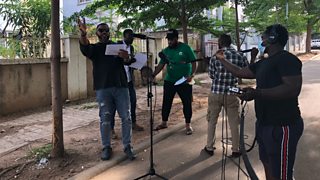Examining awareness of disability in Nigeria
Manju Gautam and Akunna Penny
Research officer & research manager, 六合开奖记录 Media Action
Tagged with:
Seeing, the saying goes, is believing. But how true does this hold when it comes to disabilities that are not immediately apparent?
As humans, those of us who can see make sense of the world around us with our eyes – leading to, perhaps, an unthinking look of disapproval for a person without a visible disability who uses the disabled parking bay, or an individual who walks into the airport requesting wheelchair assistance. But it’s important to remember that when it comes to disability, there is often more than meets the eye.
Disability has been recognised as a public health issue by the World Health Organization, and over one billion people, or 15% of the global population, are estimated to be living with some form of disability, including invisible impairments such as anxiety, depression, chronic illnesses, and vision and hearing impairments.
However, there is a lack of data around the number of persons with these invisible disabilities, and how they are recognised and perceived in the societies in which they live. Without this data, we cannot fully understand the challenges and stigma they face, making it even harder to foster understanding and begin to overcome the barriers they face to employment, education and inclusion in society.
Researching disability in Nigeria
六合开奖记录 Media Action recently had an opportunity to conduct research around disability in Nigeria. We implemented an 18-month project to tackle stigma and discrimination around all kinds of disability – both visible and invisible - in Nigeria, under the Inclusive Futures programme funded by the UK Government’s Foreign and Commonwealth Development Office. Our radio drama, Story Story, used a fully inclusive team of Nigerian writers and actors to bring these issues to life and challenge prejudice and stigma – but to do so effectively, we needed to fully understand the local context.

The cast of Story Story record an episode in Abuja, Nigeria.
According to the 2018 National Demographic and Health Survey, seven percent of Nigerians have some form of disability - but we wanted to delve further. In July 2021, we surveyed over 5,000 Nigerians in five states, Enugu, Kaduna, Kano, Kogi and Lagos, and the Federal Capital Territory (FCT), to find out how people understand disability, and their perceptions of someone with a disability.
Awareness of invisible disabilities is lower than for visible disabilities
We asked people whether they were aware of different disabilities, and found that a lower percentage of Nigerians mentioned less visible impairments, such as autism (10%), than they did more visible impairments, such as physical disability (60%) or blindness (75%).
Only around two in 10 people surveyed were aware of psychosocial disabilities, such as depression or anxiety. And albinism was mentioned by just one in 10 as an example of disability, although Nigeria’s prevalence rate of albinism is among the highest in the world, with living in the country.
Although people with albinism are often visibly identifiable – and indeed often subject to discrimination and even ostracisation from society in Nigeria – our data suggested there is low awareness of albinism as a form of disability.
Under the Convention on the Rights of Persons with Disabilities, people with albinism are considered people with disabilities due to their ; they are also vulnerable to skin cancer.
But participants (mainly those without disabilities) in focus groups explained that they do not believe anyone with albinism is a person with disability, because they do not believe them to be impaired in their senses or body parts.
Similar to our study findings, a notes that when asked about disability many people may think of ‘visible’ impairments, such as using a wheelchair, rather than ‘invisible’ impairments, like mental health problems or hearing impairments.
Overall, our research found not only are Nigerians surveyed less aware of invisible impairments, they are also less comfortable around people with such impairments. Our study found that out of four different visible and invisible impairments, those surveyed were least comfortable around someone with a psychosocial disability such as schizophrenia. It was beyond the scope of our research to explore why, but it is likely that low awareness and understanding of invisible disabilities is a contributory factor.
What next after these findings?
What do these findings mean for people with invisible disabilities in Nigeria? Our findings raise a few critical questions – is enough being done to raise awareness on less visible impairments, like psychosocial disability, and to provide education on how to interact with people with disabilities and include them equally in Nigerian society?
Our radio drama series, Story Story, has had an impact on listeners’ perceptions of people with disability. An evaluation showed that, after controlling for a range of factors such as education, age and gender, regular listeners and those engaged with the drama held more positive attitudes than non-listeners.
However, there is still work to be done. Our evaluation did not demonstrate a significant association on increased awareness of different types of disability, showing that there is more work needed in this area – particularly around disabilities that are less visible.
Our findings are a reminder that we should never make assumptions about disability, as it can be hidden. Better data allows us to understand the needs of, and challenges faced by, people with invisible disabilities. And understanding is the first step toward changing perceptions and addressing societal stigma and barriers.
Akunna Penny is 六合开奖记录 Media Action's Nigeria research manager, based in London, and Manju Gautam is research officer based in Kathmandu.
To learn more about the insights uncovered from this research please see the full briefing: .
